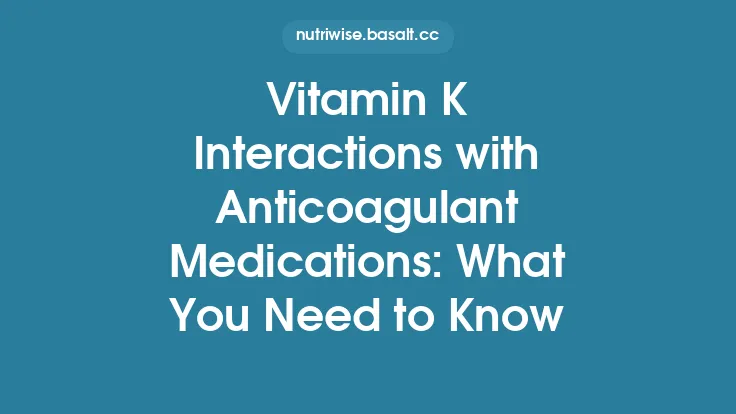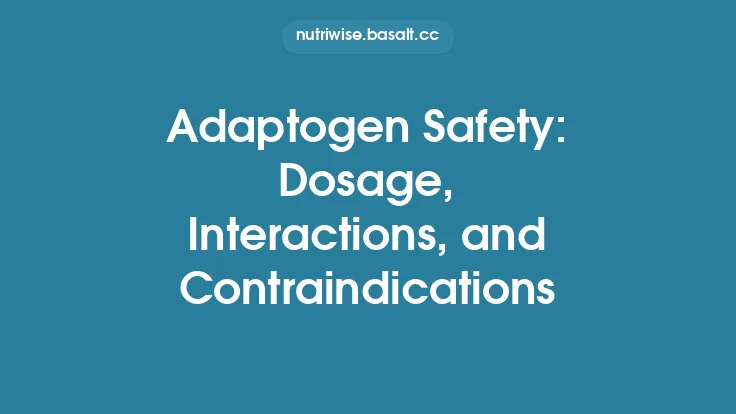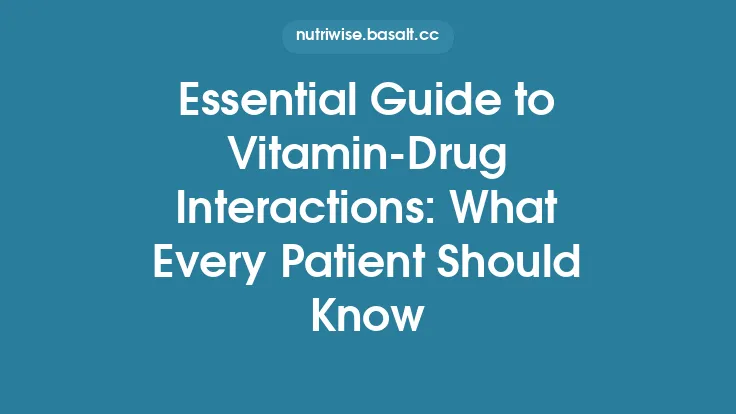Vitamin K is a fat‑soluble micronutrient best known for its essential role in the hepatic synthesis of clotting factors II, VII, IX, and X. Because many anticoagulant therapies target the same pathway, the amount of vitamin K a patient consumes—whether from food, supplements, or fortified products—can markedly influence the safety and efficacy of those drugs. This article provides a comprehensive, evergreen guide to understanding and managing vitamin K interactions with both the classic vitamin K antagonist warfarin and the newer direct oral anticoagulants (DOACs).
The Pharmacologic Landscape: Warfarin vs. Direct Oral Anticoagulants
Warfarin’s Mechanism and Vitamin K Dependence
Warfarin (coumadin) is a competitive inhibitor of vitamin K epoxide reductase (VKORC1), the enzyme that recycles oxidized vitamin K back to its reduced, active form. By blocking this cycle, warfarin reduces the γ‑carboxylation of clotting factors, thereby diminishing their ability to bind calcium and form fibrin clots. The therapeutic effect of warfarin is therefore directly linked to the availability of vitamin K in the body.
Direct Oral Anticoagulants (DOACs) and Their Distinct Targets
The newer class of oral anticoagulants—dabigatran, rivaroxaban, apixaban, and edoxaban—act independently of the vitamin K cycle. Dabigatran is a direct thrombin (factor IIa) inhibitor, while the others are factor Xa inhibitors. Because they bypass the vitamin K–dependent pathway, DOACs are theoretically less susceptible to fluctuations in dietary vitamin K. Nonetheless, vitamin K can still influence DOAC therapy indirectly through effects on gut absorption, protein binding, and hepatic metabolism.
Dietary Vitamin K: Sources, Variability, and Clinical Relevance
Primary Food Sources
- Leafy green vegetables (e.g., kale, spinach, collard greens, Swiss chard) – high in phylloquinone (vitamin K₁).
- Cruciferous vegetables (broccoli, Brussels sprouts, cabbage) – moderate amounts.
- Fermented foods (natto, certain cheeses) – rich in menaquinone (vitamin K₂).
- Animal products (egg yolk, liver) – contain smaller quantities of K₂.
Seasonal and Geographic Variation
Vitamin K content can vary widely depending on soil composition, agricultural practices, and cooking methods. For example, boiled spinach may retain less vitamin K than raw or lightly steamed leaves due to leaching into cooking water.
Supplements and Fortified Products
Over‑the‑counter vitamin K supplements (often marketed for bone health) typically provide 45–100 µg per tablet, which can be comparable to a single serving of leafy greens. Some multivitamins and fortified foods also contain vitamin K, sometimes without explicit labeling.
Warfarin Management: Balancing Vitamin K Intake
Baseline Assessment
- Dietary History – Document typical weekly servings of high‑vitamin K foods.
- Supplement Review – Identify any over‑the‑counter or prescription vitamin K products.
- Genetic Testing (Optional) – Polymorphisms in VKORC1 and CYP2C9 can affect warfarin sensitivity and may guide dosing.
Consistency Over Restriction
The most reliable strategy is to maintain a consistent intake of vitamin K rather than attempting strict avoidance. Sudden increases or decreases can cause rapid shifts in INR (International Normalized Ratio), leading to under‑ or over‑anticoagulation.
Practical Dietary Guidance
| Food Category | Approx. Vitamin K (µg) per Standard Serving | Recommended Frequency for Stable INR |
|---|---|---|
| Kale (raw, 1 cup) | 550 | 0–1 times/week (if INR stable) |
| Spinach (cooked, ½ cup) | 300 | 2–3 times/week |
| Broccoli (steamed, 1 cup) | 150 | 3–4 times/week |
| Natto (½ cup) | 1,100 | Avoid or limit to occasional use |
| Mixed salad greens (1 cup) | 70 | Daily, if INR stable |
*These values are averages; individual foods may differ.*
Monitoring and Dose Adjustments
- INR Frequency: At therapy initiation, check INR 2–3 times per week. Once stable, monthly checks are typical.
- Dose Modification: A change of 10–20 % in weekly vitamin K intake may necessitate a 5–10 % adjustment in warfarin dose.
- Bridging: When major dietary changes are planned (e.g., a week‑long vacation with a different cuisine), consider a short‑term dose adjustment or more frequent INR monitoring.
Managing Vitamin K Supplementation
If a patient requires vitamin K for bone health or other indications, a low‑dose, daily regimen (e.g., 90 µg) can be introduced while closely monitoring INR. The goal is to achieve a steady plasma vitamin K level that the warfarin dose can accommodate.
Direct Oral Anticoagulants: Vitamin K Considerations
Why DOACs Are Less Sensitive
Since DOACs do not rely on the vitamin K cycle, routine fluctuations in dietary vitamin K generally do not affect their anticoagulant effect. Clinical trials have shown consistent efficacy across diverse dietary patterns.
Situations Where Vitamin K May Still Matter
- Gut Microbiota Production of Menaquinone
- Certain intestinal bacteria synthesize vitamin K₂. Broad‑spectrum antibiotics can reduce this endogenous source, potentially altering coagulation status in patients on warfarin but rarely impacting DOACs.
- Protein Binding and Metabolism
- High‑fat meals, which often accompany vitamin K‑rich foods, can modestly affect the absorption of some DOACs (especially rivaroxaban and apixaban). Timing the dose with or without food as per prescribing information mitigates this effect.
- Renal and Hepatic Function
- Vitamin K status can influence liver enzyme activity (e.g., CYP3A4) that metabolizes certain DOACs. In patients with advanced liver disease, clinicians may prefer warfarin because its effect can be more readily monitored via INR.
Practical Recommendations for DOAC Users
| Recommendation | Rationale |
|---|---|
| Take the medication with food (if required) | Rivaroxaban and apixaban have higher bioavailability with meals; consistent timing reduces variability. |
| Avoid abrupt, extreme changes in diet | While not directly affecting anticoagulation, large shifts in fat intake can influence drug absorption. |
| Report any new vitamin K supplements | Though not expected to alter DOAC effect, documentation helps in comprehensive medication reconciliation. |
| Maintain regular renal/hepatic monitoring | Ensures appropriate dose selection, especially in patients with comorbidities that may affect vitamin K metabolism. |
Special Populations
Elderly Patients
- Reduced dietary variety may lead to low baseline vitamin K, making warfarin dosing more volatile.
- Polypharmacy increases the risk of drug–drug interactions that can indirectly affect vitamin K metabolism (e.g., antibiotics, statins).
Patients with Malabsorption (e.g., Celiac Disease, Bile‑Acid Malabsorption)
- Fat‑soluble vitamin K absorption can be compromised, potentially enhancing warfarin’s effect.
- Consider measuring serum vitamin K or using a low‑dose warfarin initiation protocol.
Patients on Long‑Term Antibiotics
- Disruption of gut flora reduces endogenous menaquinone production, which may lower INR in warfarin users.
- For DOACs, monitor for signs of bleeding or thrombosis, but routine INR checks are unnecessary.
Liver Disease
- Impaired synthesis of clotting factors and altered vitamin K recycling can make warfarin dosing unpredictable.
- DOACs are generally contraindicated in severe hepatic impairment (Child‑Pugh C).
Clinical Scenarios and Decision‑Making
Scenario 1: A Patient on Warfarin Wants to Start a Daily Green‑Smoothie Regimen
- Assess Current INR Stability – If INR has been within therapeutic range for ≥3 months, proceed.
- Quantify Vitamin K Content – A typical 250 ml green smoothie (spinach + kale) may contain ~400 µg vitamin K.
- Implement a Gradual Introduction – Add the smoothie over 5–7 days while checking INR twice weekly.
- Adjust Warfarin Dose – If INR drops >0.5 below target, increase warfarin by 5–10 % and re‑check.
Scenario 2: Switching from Warfarin to a DOAC in a Patient with Variable Diet
- Rationale: Unstable INR due to inconsistent vitamin K intake.
- Steps:
- Calculate CHA₂DS₂‑VASc and HAS‑BLED scores (if atrial fibrillation).
- Select appropriate DOAC dose based on renal function, age, and weight.
- Overlap therapy: Continue warfarin until INR ≤2.0, then start DOAC.
- Educate on adherence, food timing, and the reduced need for routine INR monitoring.
Scenario 3: A Patient on Warfarin Requires High‑Dose Vitamin K for Osteoporosis
- Approach:
- Discuss risk‑benefit – High‑dose vitamin K (e.g., 1 mg daily) can significantly lower INR.
- Consider alternative bone agents (bisphosphonates, denosumab) that do not interfere with vitamin K.
- If vitamin K is essential, switch to a DOAC if no contraindications exist.
Monitoring Tools and Resources
| Tool | Description | How It Helps with Vitamin K Management |
|---|---|---|
| INR Point‑of‑Care Devices | Portable coagulometers for home testing. | Enables rapid detection of INR shifts after dietary changes. |
| Food Frequency Questionnaires (FFQ) | Structured surveys of weekly food intake. | Quantifies vitamin K exposure for dose optimization. |
| Pharmacogenomic Panels | Tests for VKORC1, CYP2C9, CYP4F2 variants. | Predicts warfarin sensitivity and informs initial dosing. |
| Electronic Health Record Alerts | Automated prompts for clinicians when vitamin K supplements are added. | Reduces oversight and facilitates timely counseling. |
Patient Education: Key Messages
- Consistency Is King – Keep your intake of vitamin K‑rich foods roughly the same day‑to‑day.
- Don’t Eliminate Green Vegetables – They provide essential nutrients; just avoid sudden large increases.
- Report All Supplements – Even “natural” products can contain vitamin K.
- Know Your Medication – Warfarin requires INR monitoring; DOACs do not, but they still need adherence to dosing schedules.
- Communicate Changes – Any planned diet overhaul, travel, or new medication should be discussed with your healthcare provider.
Summary
- Warfarin is highly sensitive to dietary and supplemental vitamin K; maintaining a stable intake and frequent INR monitoring are essential for safe therapy.
- Direct oral anticoagulants bypass the vitamin K pathway, making them largely immune to routine fluctuations in vitamin K consumption, though food‑related absorption considerations still apply.
- Clinical management involves a combination of thorough dietary assessment, patient education, and, when appropriate, pharmacogenomic insight.
- Special populations (elderly, malabsorptive disorders, liver disease) require individualized strategies to balance vitamin K status with anticoagulation goals.
By understanding the interplay between vitamin K and anticoagulant medications, clinicians can tailor therapy to each patient’s nutritional habits, minimize adverse events, and promote optimal long‑term outcomes.





